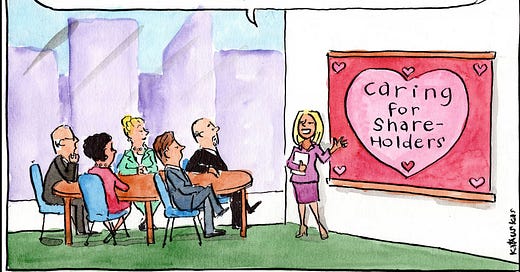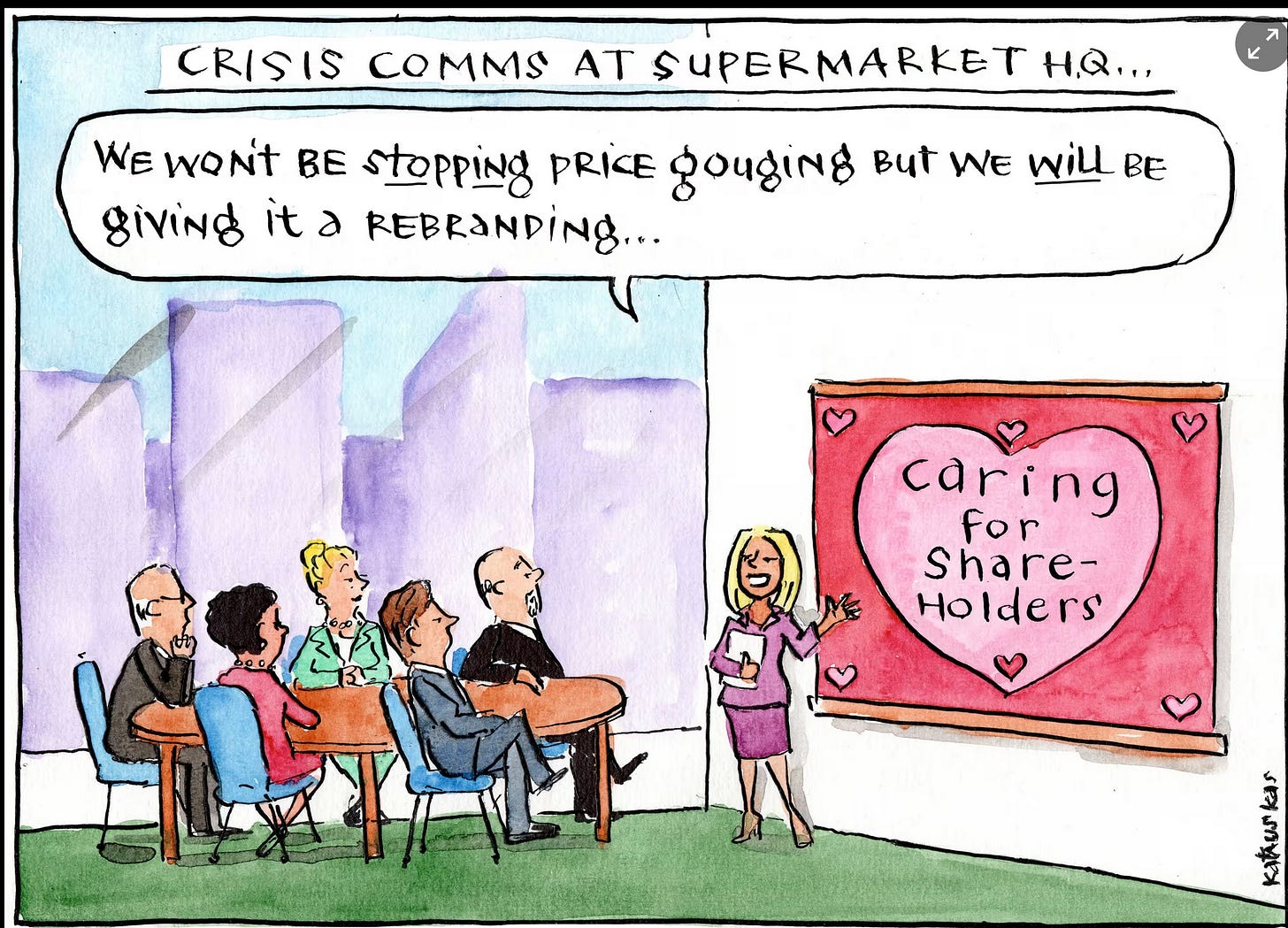For corporations, greed is good – so how can Australia really tackle price gouging?
Restoring wages, breaking up dominant firms and more extensive price regulation are all ways we can make an economy that serves people, not profits
My latest piece in The Guardian.
The long-running debate over “price gouging” should have been settled yesterday by the release of a report by Allan Fels, the former chair of the Australian Competition and Consumer Commission (ACCC). The report, commissioned by the ACTU, found that a wide range of Australian industries are characterised by limited competition, giving powerful firms ample scope to extract large profit margins.
Consistent with international evidence, most of the inflation observed in the wake of the pandemic was captured in the form of increased profit margins. Contrary to the dominant economic model – in which inflation begins in the labor market, with higher wages being passed on to prices – the recent inflation has seen wages lag far behind prices. In some countries, notably the US, real wages have recovered, but in Australia they are still well below the pre-Covid level for most workers.
The facts are clear enough. But they raise the question: why now? In addition to market power, much of the discussion of price gouging has focused on denunciations of corporate greed and on the various tricks (such as “shrinkflation”) that can be used to raise prices surreptitiously.
But personal greed isn’t new (it’s one of the seven deadly sins, after all). There’s no obvious reason to think that corporate managers have become personally greedier in the years since the pandemic.
More importantly: greed in the form of profit maximisation is the driving engine of capitalism. That’s why Gordon Gecko in Wall Street, echoing his real-life models Ivan Boesky and Michael Milken, said: “Greed, for lack of a better word, is good.”
In corporate-speak, this is usually shrouded in euphemisms like “shareholder value”, or softened by pledges of “corporate social responsibility”, but profit is still the main goal.
Devices like shrinkflation have also been around for a long time. In his classic 1933 work The Theory of Monopolistic Competition, which (along with the contemporaneous work of Joan Robinson) introduced the idea of imperfect competition, Edwin Chamberlin described this and other deceptive practices.
As for uncompetitive markets, this is certainly nothing new in Australia. It has mostly got worse over time, particularly as public infrastructure services have been sold off to private monopolies; but this trend hasn’t been uniform. Notably, the arrival of Aldi has provided some competition for the dominant supermarket chains, Woolworths and Coles. And there has been no particular change that would explain the upsurge in profit margins over the last few years.
Rather, recent inflation has resulted from the interaction between corporate market power and pent-up demand from forced saving during the lockdowns. Economic analysis, including my own work with Flavio Menezes (quoted in the Fels report), shows that increased demand allows firms with market power to increase their margins, exacerbating any initial inflationary shock.
Unfortunately, the process does not work smoothly in reverse. Because wages are slow to adjust, a policy-induced slowdown – such as that now being engineered by the Reserve Bank – will prevent wages from catching up to past inflation, effectively freezing higher profit margins into place.
What then, should be done?
First, instead of focusing solely on the consumer price index as the measure of the “cost of living”, we should be looking at profit margins – largely determined by the gap between prices and wages. Restoring wages is more important than a rapid return to an arbitrary target rate of CPI inflation.
In the longer term, we need to tackle the problems of an economy in which most markets are dominated by a handful of firms. In part, this can be achieved by strengthening the powers of the ACCC. Most importantly, as suggested in the Fels report, there is the possibility of breaking up firms that are already dominant in their markets – Qantas is an obvious target here.
But in an economy as small as Australia’s, dominance by a handful of firms is inevitable in many cases. One possible solution, suggested in the Fels report, is more extensive price regulation.
In the case of infrastructure utilities, the remedy in most cases is to abandon the failed experiments of privatisation and corporatisation and return to public ownership. Ideally, this would involve a statutory authority model in which the objective is to maximise social benefits rather than profits, while setting prices sufficient to cover operating and capital costs.
It’s another idea that’s been around for a long time. But it’s one that might be worth trying.





Don't forget monopsony. Walmart and Amazon don't make their money by gouging customers but by gouging suppliers, allowing them to drive myriads of smaller firms out of business with unbeatably low prices. I recall seeing an article on the bill of parts for an Amazon Echo smart speaker. The conclusion was that Amazon were making no money on the equipment, which is very good value for the consumer. But it ties them into a profitable and monopolistic service ecosystem, with music, audiobooks, streaming videos, and online shopping. Amazon's AI home assistant Alexa has just two rivals, Google Assistant and Apple's Siri. The barriers to entry are now very high.
Now, if they introduce a "buy a share in Coles/Woolworths loyalty card" then customers might be induced to support zero taxation for the major shareholders the way tradie investment in rental homes brings wider support for special tax breaks and other advantages to large corporate developers and landlords at the expense of people who want to buy their own homes.